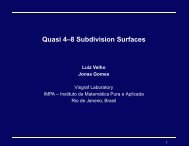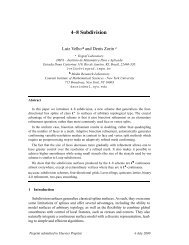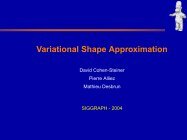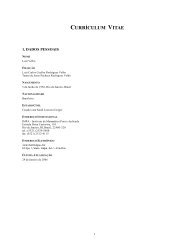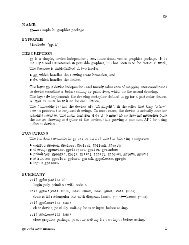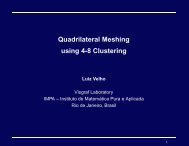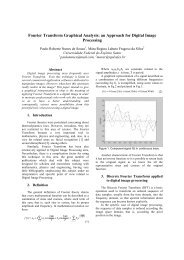Mathematical Optimization in Graphics and Vision - Luiz Velho - Impa
Mathematical Optimization in Graphics and Vision - Luiz Velho - Impa
Mathematical Optimization in Graphics and Vision - Luiz Velho - Impa
You also want an ePaper? Increase the reach of your titles
YUMPU automatically turns print PDFs into web optimized ePapers that Google loves.
1.2. MATHEMATICAL MODELING AND ABSTRACTION PARADIGMS 7<br />
In order to represent the different length values (real numbers) we must look for<br />
a discretization of the set of real numbers. A widely used tecnhique is the float<strong>in</strong>g<br />
po<strong>in</strong>t representation. Note that <strong>in</strong> this representation the set of real numbers is<br />
discretized <strong>in</strong> a f<strong>in</strong>ite set of rational numbers. In particular this implies that the<br />
concept of commensurability is lost when we pass from the mathematical to the<br />
representation universe.<br />
From the po<strong>in</strong>t of view of the implementation universe the float<strong>in</strong>g po<strong>in</strong>t representation<br />
can be atta<strong>in</strong>ed by used the IEEE st<strong>and</strong>ard, which is implement <strong>in</strong> most<br />
of the computers. A good reference for this topic is (Higham, 1996).<br />
The previous example, although simple, illustrates the fundamental problem of<br />
model<strong>in</strong>g <strong>in</strong> computational mathematics. Of particular importance <strong>in</strong> this example<br />
is the loss of <strong>in</strong>formation we face when mov<strong>in</strong>g from the mathematical universe<br />
to the represenation universe (from real numbers to their float<strong>in</strong>g po<strong>in</strong>t representation),<br />
where the concept of commensurability is lost. In general, pass<strong>in</strong>g from<br />
the mathematical universe to the representation universe implies <strong>in</strong> a loss of <strong>in</strong>formation.<br />
This is a very subtle problem that we must face when work<strong>in</strong>g with<br />
model<strong>in</strong>g <strong>in</strong> computational mathematics, <strong>and</strong>, <strong>in</strong> particular, <strong>in</strong> computer graphics.<br />
The model<strong>in</strong>g process consists <strong>in</strong> choos<strong>in</strong>g an object from the physical world,<br />
associate to it a mathematical model, discretize it <strong>and</strong> implement it. This implementation<br />
should provide solutions to properly posed problems <strong>in</strong>volv<strong>in</strong>g the<br />
<strong>in</strong>itial physical object. Note that the loss of <strong>in</strong>formation we mentioned above is a<br />
critical factor <strong>in</strong> this cha<strong>in</strong>.<br />
We should remark that <strong>in</strong> the model<strong>in</strong>g process the association of an object<br />
from an abstraction level (universe) to the other is the most generic possible. In<br />
fact, the same object from one abstraction level may have dist<strong>in</strong>ct correspondents<br />
<strong>in</strong> the next abstraction level (we leave to the reader the task of provid<strong>in</strong>g examples<br />
for this). Instead, <strong>in</strong> the next two sections we will provide two examples which<br />
show that different objects from the physical world may be described by the same<br />
mathematical model.<br />
1.2.1 Terra<strong>in</strong> representation<br />
Consider the problem of represent<strong>in</strong>g a terra<strong>in</strong> <strong>in</strong> the computer (a mounta<strong>in</strong> for<br />
<strong>in</strong>stance). In cartography a terra<strong>in</strong> may be described us<strong>in</strong>g a height map: we





